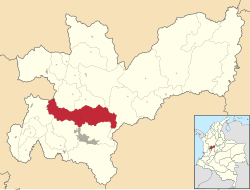
Chinchiná is a municipality located in the department of Caldas in Colombia, 17 kilometres (11 mi) southwest of Manizales. Chinchiná is rich in character and beautiful landscapes. Founded in 1857 by Antioquian colonists, Chinchiná is settled in a valley surrounded by coffee plantations, called "fincas", in the Central Cordillera of the Andes. Known as Colombia's coffee heart, the town is home to the Buendía coffee factory and Cenicafé, a coffee research center.

Montenegro is a municipality in the western part of the department of Quindío, Colombia. It is located 10 km west of the departmental capital Armenia.
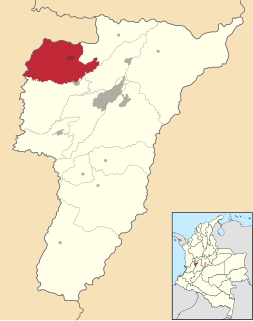
Quimbaya is a town and municipality in the western part of the department of Quindío, Colombia. It is 20 km northwest of the departmental capital Armenia. The name of the city derives from the name of the Precolumbian culture that inhabited the area, the Quimbaya civilization. Located along the Colombian coffee growing axis, the municipality was made part of the "Coffee Cultural Landscape" UNESCO World Heritage Site in 2011.

Circasia is a municipality in the northern part of the department of Quindío, Colombia. It is located 7 km north of the department's capital Armenia. Located wthin the Colombian coffee growing axis, the historic center of Circasia was made part of the "Coffee Cultural Landscape" UNESCO World Heritage Site in 2011.

Pijao is a municipality in the south-eastern part of the department of Quindío, Colombia. The township is located 31 km south of the departmental capital Armenia.
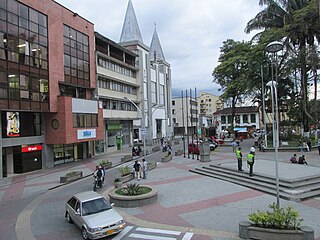
Calarcá is a municipality in the eastern part of the department of Quindío, Colombia. It is located 4 km east of the departmental capital Armenia. Its nickname is La Villa del Cacique in homage of its writers. The city was founded in 1886 by Segundo Henao during the time of colonization by people from Antioquia Department. It is the second city in Quindío with major quantity of inhabitants. In 2016 it had an estimated population of 78,779, of which 59,986 live in the main urban zone. Located along the Colombian coffee growing axis, it was made part of the "Coffee Cultural Landscape" UNESCO World Heritage Site in 2011.
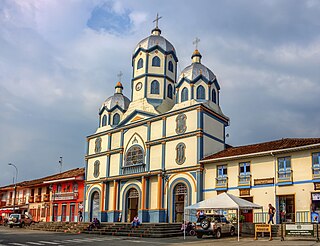
Filandia is a town and municipality in the northern part of the department of Quindío, Colombia. It is located on the west side of Cordillera Central of the Andes mountain range running through central Colombia, 26 km north of the departmental capital Armenia. It is the northernmost of twelve municipalities that form Quindío, the second smallest department of Colombia. It houses a small community economically supported by agriculture and tourism.

Génova is a municipality in the southern part of the department of Quindío, Colombia. It is located 52 km south of the departmental capital Armenia.

The Colombian coffee Region, also known as the Coffee Triangle is a part of the Colombian Paisa region in the rural area of Colombia. It is famous for growing and producing the majority of Colombian coffee. There are four departments in the area: Caldas, Quindío, Risaralda and Tolima. The most visited cities are Manizales, Armenia, Pereira, and Ibagué.

Aguadas is a town and municipality in the Colombian Department of Caldas. It is bounded on the north by Abejorral, on the east by Sonsón, Salamina in the southeast, on the south by Pacora, on the west with Caramanta and Valparaiso, and the northwest with La Pintada. The municipality of Aguadas was founded in 1808 by José Narciso Estrada. It is located in the northern part of the department. In addition to the fame of Aguadeño Hats, which are very similar to the Panama Hat made of palm straw called iraca in Colombia. Aguadas offers visitors its historic center, declared a National Monument in 1982. It has a temperate climate thanks to the variety of climates ranging from warm to moor.

Pácora is a town and municipality in the Colombian Department of Caldas. It is located in northern Caldas-Department, on the slopes of the Andes Central Mountains of the Republic of Colombia. With an average annual temperature of 18 °C, the town is bordered to the northeast with Aguadas, Caldas, to the south with Salamina, Caldas and La Merced, and to the west separated by the Cauca River, Marmato-Caldas and Caramanta-Antioquia department. The villages in Pácora are San Bartolomé, Castilla, Las Coles, Los Morros, San Lorenzo and Buenos Aires.

Palestina is a town in the south central region of the state of Caldas, Colombia. Located in the Triangle of Coffee Area, with a culture and tradition related to the colonization of Antioquia and the coffee growing. Because of this, the historic center of the town and surrounding rural areas were named part of the "Coffee Cultural Landscape" UNESCO World Heritage Site in 2011.

Salamina is a town and municipality in the Colombian department of Caldas. It is located north of the department and has a township called San Felix. It was declared a national monument and historic heritage of mankind.

Supía is a town and municipality in the Colombian Department of Caldas. Located along the Colombian coffee growing axis, it was part of the "Coffee Cultural Landscape" UNESCO World Heritage Site in 2011.

Villamaría is a town and municipality in the Colombian Department of Caldas. Located in the Colombian coffee growing axis, it was made part of the "Coffee Cultural Landscape" UNESCO World Heritage Site in 2011.
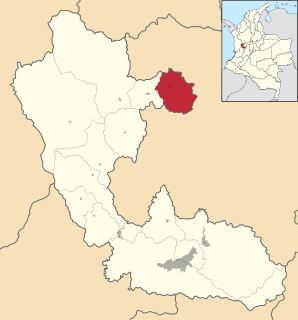
Quinchía, also known as Villa de los Cerros, is a town and municipality in the Department of Risaralda, Colombia. In 1985 Quinchía was described as the prettiest village of Risaralda, for governor of that department. Sebastian Belalcázar was the first European to arrive in this territory. Located in the Colombian coffee growing axis, it was made part of the "Coffee Cultural Landscape" UNESCO World Heritage Site in 2011.
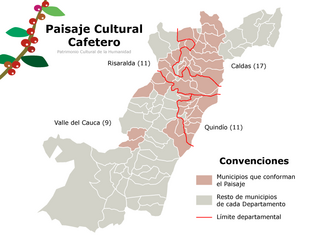
Coffee production in Colombia has a reputation for producing mild, well-balanced coffee beans. Colombia's average annual coffee production of 11.5 million bags is the third total highest in the world, after Brazil and Vietnam, though highest in terms of the arabica bean. The beans are exported to United States, Germany, France, Japan, and Italy. Most coffee is grown in the Colombian coffee growing axis region, while other regions focus on quality instead of volumes, such as Sierra Nevada de Santa Marta. In 2007, the European Union granted Colombian coffee a protected designation of origin status. In 2011, UNESCO declared the "Coffee Cultural Landscape" of Colombia, a World Heritage site.

The National Monuments of Colombia are the set of properties, nature reserves, archaeological sites, historic districts, urban areas and property that, for values of authenticity, originality, aesthetics, and artistic techniques, are representative of Colombia and constitute core elements of its history and culture. The cultural heritage of Colombia includes material and immaterial assets "which are an expression of the Colombian nationality", in accordance with Law No. 1185 (2008). As of December 2011, 1079 National Monuments have been declared. A further sixteen candidate sites have been identified for future declaration.
